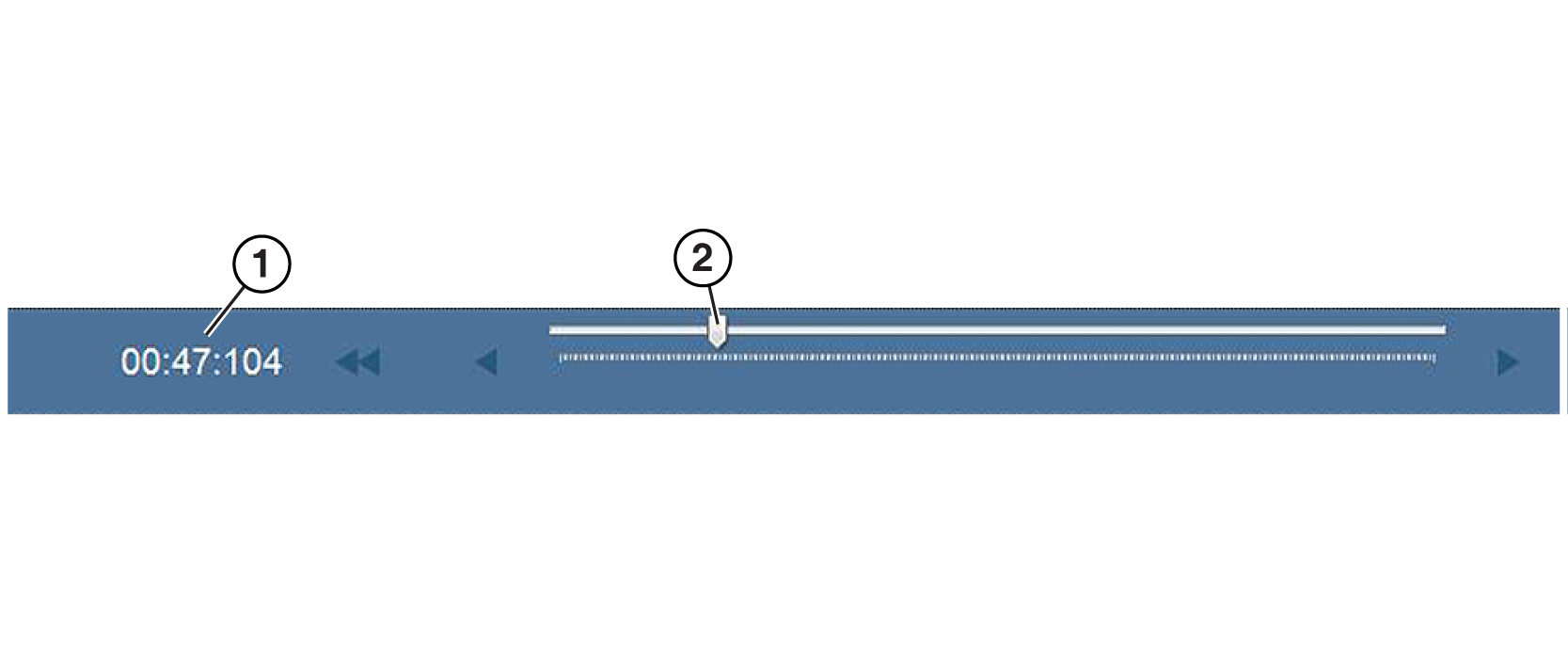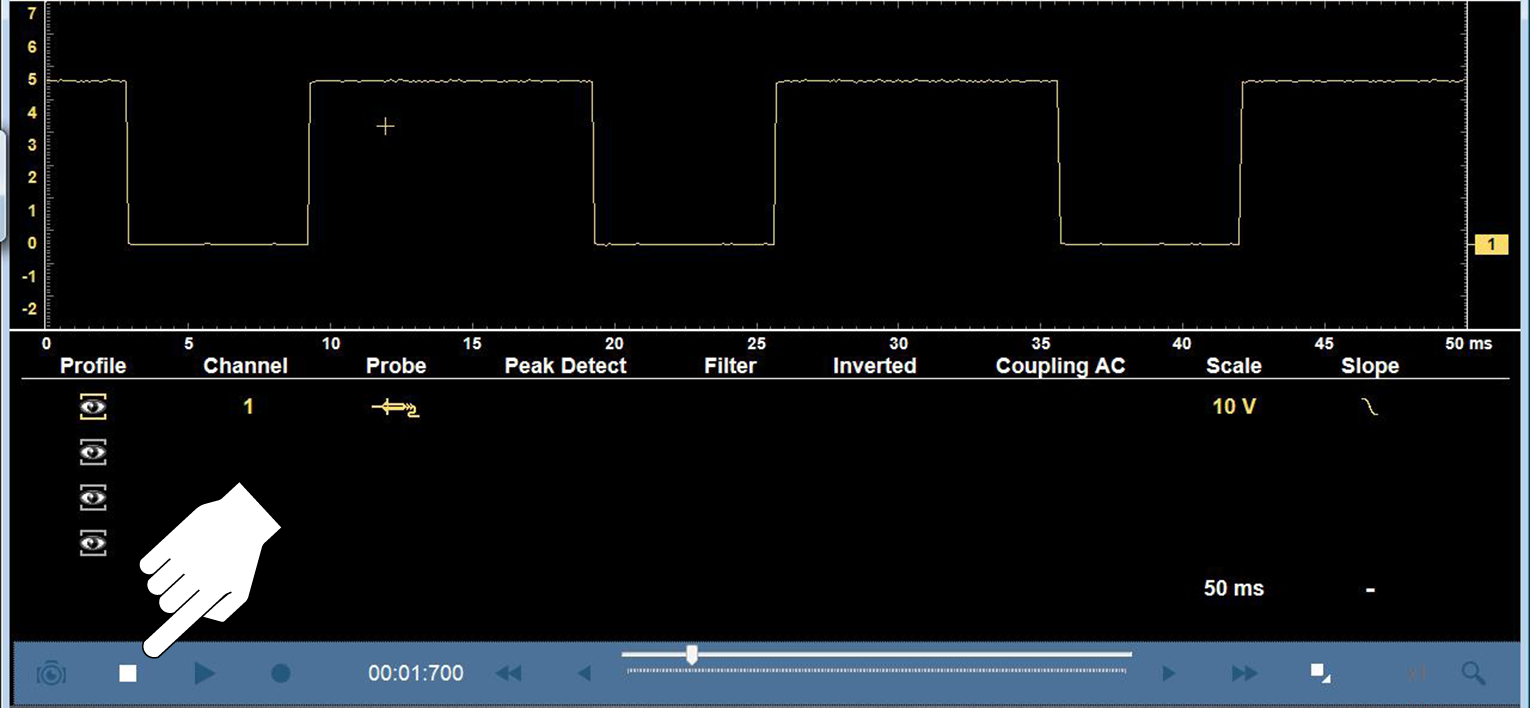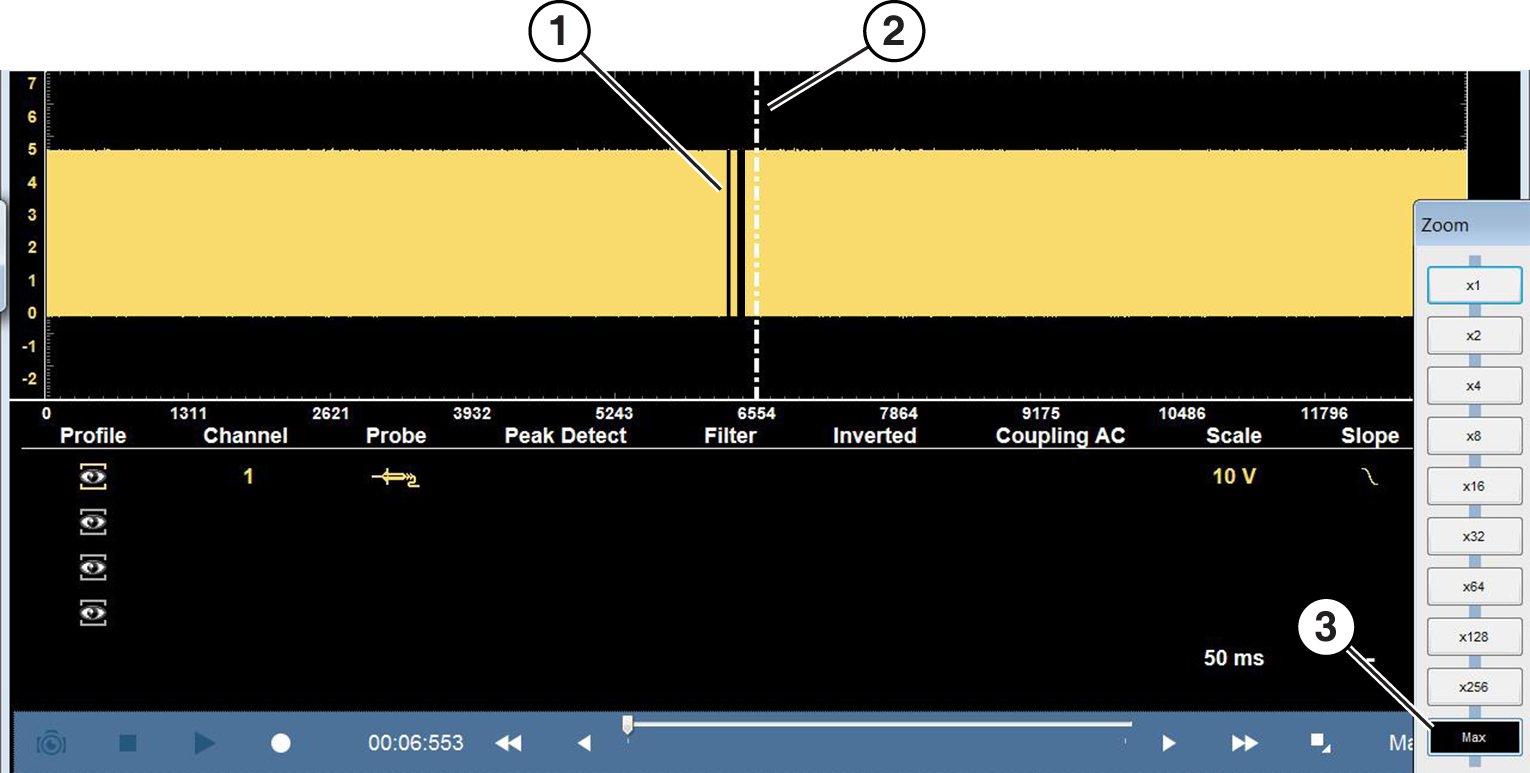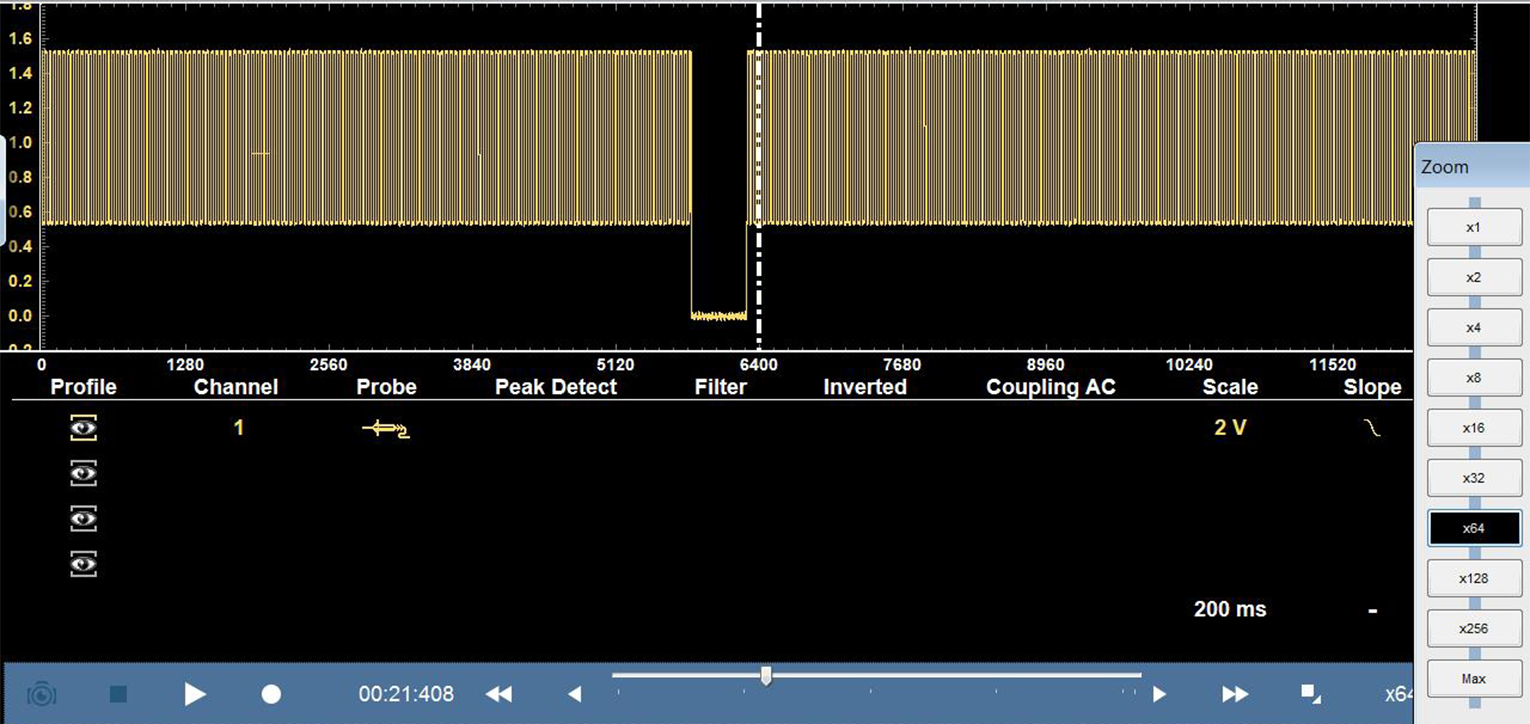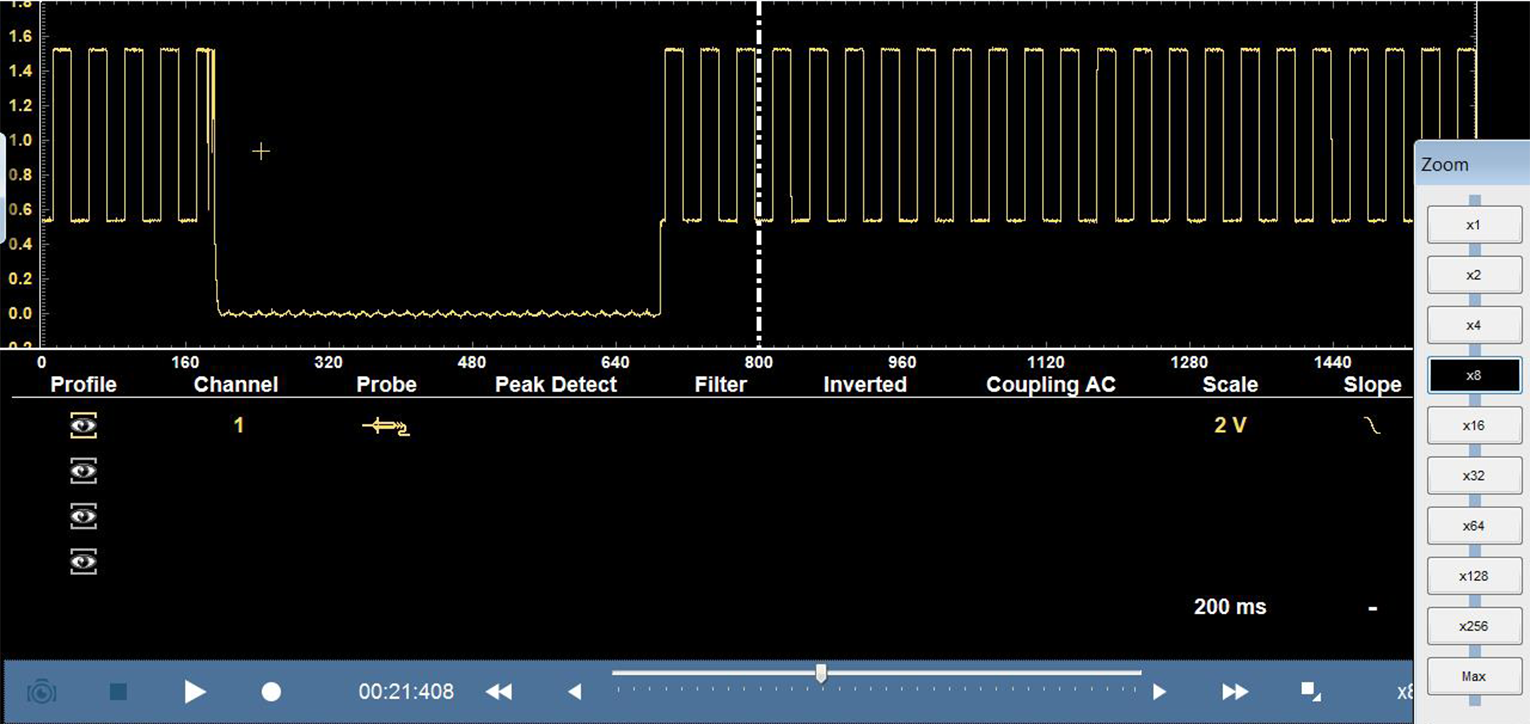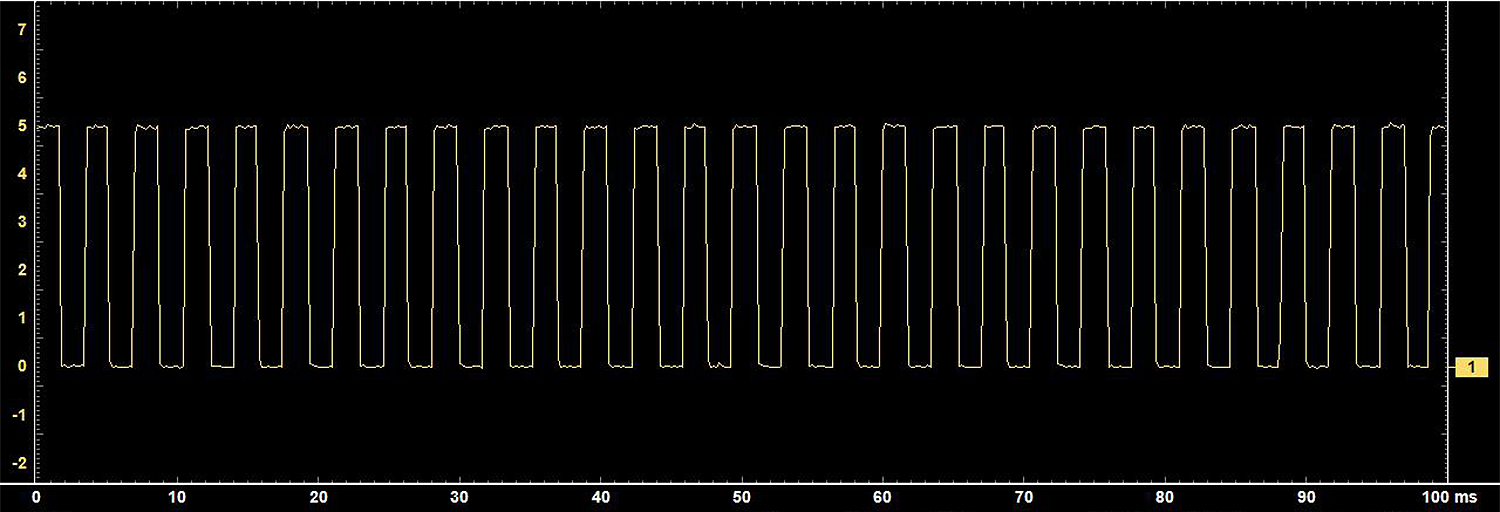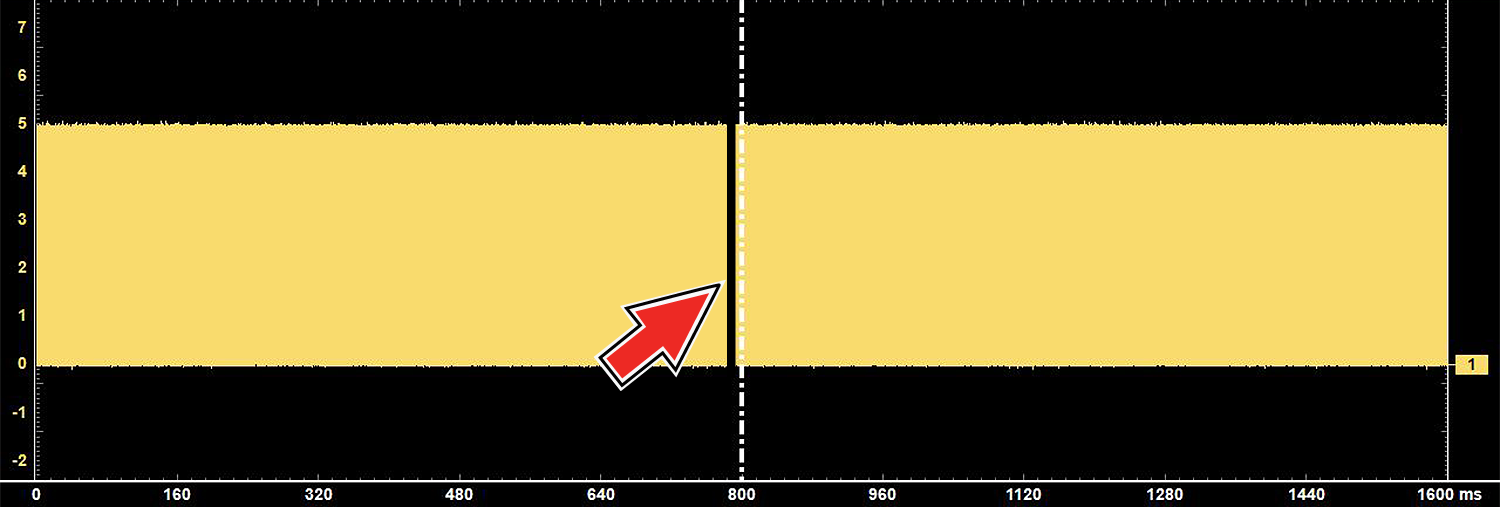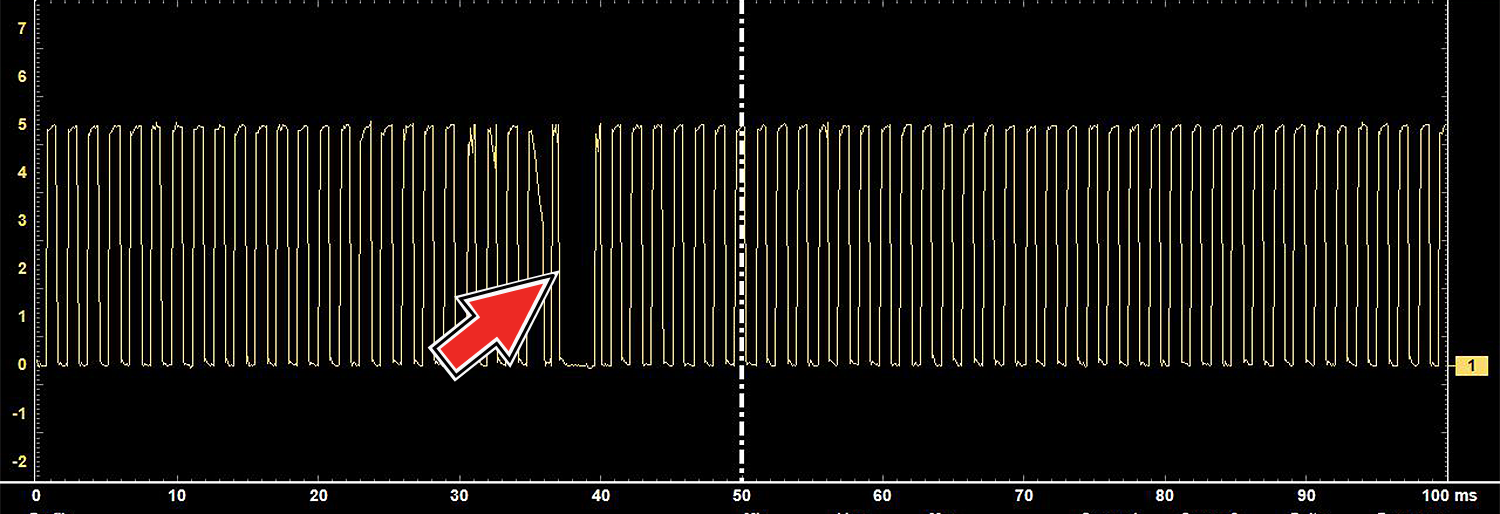The primary purpose and advantage of the Lab Scope and Graphing Multimeter, is their ability to capture, store and playback data (test signals). Having this ability can be invaluable when diagnosing intermittent issues, by providing you the ability to navigate through the data in detail to find events of interest, such as glitches and signal losses. The following sections describe the basics of the data buffer and the two basic modes of operation, Capture Mode and Review Mode.
To gain a better understanding of the capabilities of the scope and the basics of capturing and reviewing data, understanding what the data buffer is and how it works is important.
The Lab Scope and Graphing Multimeter have the capability to capture, store and playback data (test signals) utilizing internal buffer storage memory. When a test function is selected (e.g. Lab Scope > DC Volts), the data is automatically stored in buffer memory, until the Pause icon is selected.
The amount of data you can capture is limited to a predetermined “total buffer memory” size. When the buffer memory reaches its full capacity, the data buffer will continue to store new data, however earlier stored data will be removed to allow room for the new data being stored. The most recent data is always available for review when the scope is paused, and can be reviewed using the toolbar controls
As a visual aid, a graphic Data Buffer Slider
In addition, a Data Buffer Position Counter
| 1. | Data Buffer Position Counter (XX (minutes): XX (seconds): XXX (thousandth of a second) |
| 2. | Data Buffer Indicator Slider |
Whenever you open Lab Scope or the Graphing Multimeter, the device is in Capture Mode. In Capture Mode, data is continuously being captured and stored in buffer memory at the same time it is being displayed onscreen.
Data is continuously stored in buffer memory with or without an active input test signal or trigger.
To help you understand how to work with captured data, an important concept to remember is that data is captured over a period of time. Therefore there is a direct relationship between the length of time the data is captured in, and the resultant level of detail you will have when reviewing it.
As every testing situation is different, the following is provided only as a guide when capturing data to provide the best flexibility when reviewing the data to find events.
In most situations if you start by using a sweep setting that is best suited for viewing the waveform “live”, or at a setting that provides the best detail to the naked eye, this will allow you to either see the event you are looking for “live, or allow you to use the zoom feature (in Review Mode) to zoom out (2, 8, 32X etc.) and then search through the data buffer for events of interest.
It is important to remember that whatever sweep setting you use during data capture is what the 1X zoom level will be when you switch to Review Mode. Therefore, if you capture data using a sweep setting where the pattern displayed is tightly compacted (can’t visually see detail), then when you try to use zoom you will not be able to see any detail, as you will only be able to zoom out from the setting where you originally captured the data (displaying an even greater level of compacted data).
In other situations you may need to start at a faster sweep (shorter time) to capture more detail “live”, then zoom out (in Review Mode) to get a wider view and then zoom in at the points of interest where you need more detail. Using this strategy you will capture less total time, but be able to see more detail.
For some situations, if the sweep setting you are using is not fast enough to capture the event your looking for, turning Peak Detect on will increase the sample rate and may allow you to see the event.
Using peak detect can also help in avoiding aliasing if the sweep time is too great for the waveform being captured. Using peak detect is not appropriate for every instance, but when using longer sweep settings, it can help increase the capture time by allowing you to capture more than you could without it and still capture dropouts and points of interest. See Peak Detect Icon for more information.
For additional information on setup and capturing data (input signals) see General Reference (Testing Strategies).
Glitches may cause drivability problems and may not turn on the MIL or set DTCs. As a general guide when looking for a suspected signal glitch, always try to verify the problem by duplicating the conditions while capturing data. Utilize the GMM to monitor the signal over longer time periods and review the histogram for possible faults.
The following control icons are active in the lower tool bar in Capture Mode..
|
Name |
Icon |
Description |
|
Snapshot |
|
Takes a “snapshot” of the data being captured, see Taking a Data Snapshot. |
|
Pause |
|
Pauses data capture |
|
Expand/Collapse |
|
Expands and collapses the Trace Detail area on the screen |
For an alternate method of capturing data, see Taking a Data Snapshot.
Data continuously stores in buffer memory until the Pause icon is selected.
Selecting the Pause icon, allows you to temporarily pause the data (input test signal) to review it in detail. See Reviewing Data and Using Zoom (Review Mode) for more information.
To resume data capture, select the Start icon.
Review Mode allows you to search through the captured data in detail to find events of interest, such as glitches and signal losses.
Press the Pause icon to open Review Mode.
To search through the captured data, select the desired control icon to move forward or backward through the data. The following control icons are active in the lower tool bar in Review Mode:
You can also use the data buffer indicator slider to quickly scroll through the captured data in buffer memory.
|
Name |
Icon |
Description |
|
Step Back |
|
Moves to the previous point in the data |
|
Back 1 Frame |
|
Moves to the previous frame in the data |
|
Start (Capture) |
|
Resumes data capture |
|
Play |
|
Plays back the captured data in a continuous loop at actual speed |
|
Forward 1 Frame |
|
Moves to the next frame in the data |
|
Step Forward |
|
Moves to the next point in the data |
|
Expand/Collapse |
|
Expands and collapses the Trace Detail area on the screen |
|
Zoom |
|
Increases or decreases magnification of the data |
As there is a direct relationship between the length of time the data is captured in, and the resultant level of detail you will have when reviewing it, review the information in Capturing Data (Capture Mode) for tips on capturing and reviewing data.
Using Zoom
The zoom function is only available in Review Mode, and can be an invaluable tool when searching for events of interest within captured data. Zoom effectively gives you the ability to change the magnification level of the signal sweep during data review.
As zoom, allows you to change the magnification level of the signal sweep, this allows you to compress or expand multiple screens of data to quickly find glitches, or signal losses.
Control icon function is normal when using zoom, with the following exception:
Forward 1 Frame / Back 1 Frame control icons - (press once) moves multiple frames relative to set magnification level (e.g. 2X setting, moves 2 frames; 16X setting, moves 16 frames).
When the Zoom icon ![]() is selected the display defaults to the "Max" magnification level and a dropdown scroll menu will display.
is selected the display defaults to the "Max" magnification level and a dropdown scroll menu will display.
The dropdown menu allows you to select the display magnification level from a range of 1X to 256X. The "Max" (maximum) option displays all data captured on one screen.
It is important to remember that whatever sweep setting you used during data capture is what the 1X zoom level will show.
The active zoom options (1X to 256X) that are selectable are dependent on the amount of data stored in the buffer. Less data captured = less zoom options.
More data captured = more zoom options.
| 1. | Glitch(s) |
| 2. | Zoom Cursor |
| 3. | Zoom Magnification Level (Max shown) |
“Max" Magnification Level - displays all captured data
When zoom levels of 2X and higher are selected, a Zoom cursor (vertical dashed line) (Figure Above) displays onscreen. The cursor is used to quickly mark and navigate to points of interest or glitch in a captured waveform.
To quickly identify a glitch in a pattern, it may be easier to initially view the waveform at a higher magnification level (e.g. 256X or "Max") to display the entire captured waveform, find the area of interest and then lower the zoom level to 8X or 2X to review that area in detail. See Zoom Example.
The Zoom cursor can be used to mark the approximate position of a glitch and can be manually dragged onscreen to the desired position. The new cursor position will be centered on the screen when a lower magnification level is selected.
This figure shows an example at 64X with the Zoom cursor positioned in the area of a signal drop glitch.
This figure shows an example at 8X of the same waveform shown above. In this figure below at 8X, the glitch is easily seen as compared to higher magnification levels.
While monitoring a MAF (Mass Air Flow Sensor) signal, the waveform displays normally. As the signal is being monitored, an erratic “condition” suddenly develops, then goes away, but may have not been observed on the screen. Stopping the data capture (when such an event occurs) allows you to analyze the waveform using a higher zoom level (wider view) to look for a glitch in the signal.
The following three illustrations show a generic square waveform to illustrate this method.
1 - Monitoring / Capturing waveform as it displays normally. You may not see a glitch, while monitoring at this setting.
2 - Pause data capture and then zoom out (this example is at 32X) to see more data and to possibly find a glitch. In this example the cursor has been placed on the right side of a glitch. The waveform is too compressed to see any detail, however the glitch stands out as a thin dark area in the waveform.
3 - Zoom back in (this example is at 2X) to view more detail in the area where the cursor was placed by the glitch.
